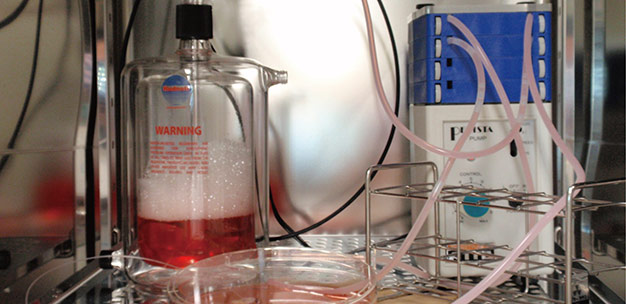Tissue-engineered uteri produce successful and healthy pregnancies in rats
Published online 6 March 2015

A recellularized uterine graft being cultured in the laboratory.
Reproduced, with permission, from Ref. 1 © 2014 Elsevier
Rats with bioengineered uteri can achieve normal pregnancies, show researchers at Keio University in Japan1. This work could lead to novel treatments for women who have abnormalities of the uterus that interfere with embryo implantation and fetal growth.
"The techniques might be clinically applicable for treating partial defects of the uterus and, in the future, perhaps for the reconstruction of the whole uterus," says Tetsuo Maruyama, a reproductive medicine specialist at Keio's School of Medicine in Tokyo.
Uterine-related infertility can sometimes be corrected surgically, but for most women with severely damaged or misshapen uteri the only way to genetically mother a child is through uterine transplantation or through the services of a surrogate ― a woman who carries the baby to term and delivers it. Both of these approaches are fraught with ethical, legal and societal issues.
Tissue engineering offers a potential alternative. The technique involves fabricating organs from an individual's own body cells and then implanting these tailor-made organs into patients. So far, doctors have only tested the approach in people who need relatively simple, hollow organs, such as bladders and windpipes. But bioengineers around the world are using similar techniques to build more complex organs, including livers, kidneys, lungs and even hearts. Perhaps the uterus would be possible, too.
Maruyama and his colleague Kaoru Miyazaki set out to test that idea in a rodent model. They surgically removed the uterus from rats and used detergents to strip the organs of all their cells. This procedure left only the underlying matrix of collagen and other structural proteins, together with the cell-free architecture of the blood vessels that surround the uterus. The researchers then reseeded this scaffold with tens of millions of primary uterine cells and mesenchymal stem cells (see image). After three days in a bioreactor, tissue analyses showed that the lab-grown organs had uterine-specific structural integrity.
The bioengineered uteri could also yield healthy pregnancies. Maruyama and Miyazaki showed that pregnancy rates and average fetal weights in rats implanted with the uterine scaffold were comparable with control rats.
Many technical obstacles remain before the same method can be applied to humans. For example, scientists will need to figure out the best ways to surgically remove uteri from donors, safely strip all the cellular remnants to avoid immune rejection, and reconstruct the organs in the lab. Once these techniques have been optimized, however, bioengineered uterine grafts could offer a revolutionary new fertility treatment.
Reference
1. Miyazaki, K. & Maruyama, T. Partial regeneration and reconstruction of the rat uterus through recellularization of a decellularized uterine matrix. Biomaterials 35, 8791-8800 (2014). | article